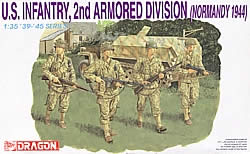| U.S.
Infantry, 2nd Armored Division |
 |
|
In 1944, the U.S. Army briefly employed the two-piece M1942 herringbone twill camouflage uniform, worn by elements of the 2nd Armored Division, including the 30th Infantry Division and 17th Engineer Battalion. The generally accepted story is that the uniform was quickly discontinued in early July after GIs were mistaken for camouflaged Germans and fired upon by their own troops, sometimes with tragic results. However, there is photographic evidence of the uniform being worn well into the later stages of summer. And of course, we know that Sgt. Saunders kept his helmet cover throughout his campaign on the old Combat television show. DML's figures are portrayed advancing cautiously, weapons drawn, equipped lightly, perhaps on patrol. This suggests their packs are with nearby support vehicles. The two soldiers with M1 Garands have ammo bandoliers slung across their chests. These come in multiple parts and hang nicely from the figures when attached to their torsos. There is the ubiquitous BAR man (not to pick on designer Ron Volstad, who has done an excellent job creating DML's figures while working within the manufacturer's stipulations, but the unschooled modeler could quickly get the idea that one in four of all American soldiers in WWII wielded the Browning Automatic Rifle, but there was only one such weapon per section of 12 men. The Thompson M1 submachine gun was generally used by company sergeants. Sculpting and molding is typical of DML's figure sets: fairly crisp and detailed, with some attention needed to taking down the mold seams. Some modelers have complained about the rather tidy nature of the trousers, suggesting they should be bloused more over the canvas leggings. A little putty will do the trick if you are so inclined. But the thinner fabric of the summer weight HBT uniform gives a different, thinner look to figures than we might be used to with infantry and paratroopers who wear jackets over their shirts and heavier woolen OD trousers. That being said, it's relatively easy to alter the shirt to represent the M1943 jacket that became commonplace in the fall of 1944, as I did with these figures for my Hürtgen Forest diorama. Merely clip off the corners of the breast pockets. The M1943 jacket had buttoned cuffs, which you can replicate with a bit of carving and putty, or leave them as is to suggest the cuffs are unbuttoned. The cargo trousers, which are nicely portrayed on the figures, also came in a straight olive drab, so no alterations are necessary. The final effect will not have the bulkier look of the M1943 worn over a shirt, and probably an undershirt as well, but you can get by. Similarly, you don't need to paint these in the camo scheme, and can just leave them as plain OD HBTs, which were common from 1942 through the summer of 1944. Just add buttons down the front and on the breast pockets. These HBTs were in a light shade of OD for the 1942 pattern, and a darker "shade 7" for the 1943 pattern. Curiously, there are no camo covered helmets in this set, just netting on three of them, and a couple of those have cloth strips woven through. You could swap in some fabric-covered helmets from DML's Marines set if you wish. The bland DML heads are, as usual, expendable. This set, along with other U.S. infantry figures from the Normandy time period, was reissued by DML in 2004 with an additional sprue of retooled weapons and gear, as well as new heads with full hair (which still are not much of an improvement over the previous heads). These updated sets are marked with an emblem on the box top. -tss- |
 |
 |
 |
 |
 |
 |
 |
 |
 |
 |
 |
 |
|
 Dragon
Models Limited
Dragon
Models Limited